The distance from 364 to 471 (number of
glyphs on the G tablet) was 107 (= 214
/ 2 = 428 / 4 = 4 * 118 - 365):
|
DEC 16 (350) |
*93 |
MARCH 19 (78) |
106 |
MARCH 20 (186 - 107) |
|
 |
 |
 |
|
Gb2-15 (270) |
Gb5-10 (443 - 80) |
Gb8-30 (3 / 2 * 314) |
|
SADALMELIK (*334) |
BEID (*62) |
HYADUM I (*63.4) |
|
Febr 18
(49 = 414) |
May 22 (54 + 22 * 4) |
23 (142 + 366 - 365 = 11 * 13) |
|
"April 11 (101) |
"April 12 (*22) |

... The
Pythagoreans make Phaeton
fall into Eridanus, burning part
of its water, and glowing still
at the time when the Argonauts
passed by. Ovid stated that
since the fall the Nile hides
its sources. Rigveda 9.73.3 says
that the Great Varuna has hidden
the ocean. The Mahabharata tells
in its own style why the
'heavenly Ganga' had to be
brought down. At the end of the
Golden Age (Krita Yuga) a
class of Asura who had
fought against the 'gods' hid
themselves in the ocean where
the gods could not reach them,
and planned to overthrow the
government. So the gods implored
Agastya (Canopus, alpha
Carinae = Eridu) for help. The
great Rishi did as he was
bidden, drank up the water of
the ocean, and thus laid bare
the enemies, who were then slain
by the gods. But now, there was
no ocean anymore! Implored by
the gods to fill the sea again,
the Holy One replied: 'That
water in sooth hath been
digested by me. Some other
expedient, therefore, must be
thought of by you, if ye desire
to make endeavour to fill the
ocean ... |
|
Takapau |
39 variants of uhi -
STOLEN by Teke from
his brother Ma'eha
[E:58-64] |
|
 |
18 |
 |
13 |
 |
7 |
 |
|
SIRRA H
(*0) |
ADHIL (*19) |
MIRA (*33) |
BHARANI (*41) |
|
ALCHITA (*183) |
SPICA (*202) |
KHAMBALIA (*216) |
ZUBEN ELGENUBI
(*224) |
|
March 21 (0h) |
39 (= 3 * 13) = 18 +
14 + 7 |
|
1 |
he tara |
kura |
|
2 |
rau
renga |
|
3 |
mahihi |
|
4 |
maito |
|
5 |
nohu |
|
6 |
hetuke |
|
7 |
mama |
|
8 |
titeve |
|
9 |
moamoa
tara |
|
10 |
huehue |
|
11 |
he
makere |
|
12 |
he
mariri |
|
13 |
he tonga |
|
|
14 |
he pua rau
hoho
|
uri |
|
15 |
tea |
|
16 |
mea |
|
17 |
para |
|
18 |
tupere ure |
|
ADHIL (*19) |
|
20 |
ravi
hakurakura |
|
21 |
naku |
|
22 |
takatore |
|
23 |
ravei |
|
24 |
he papa |
uri |
|
25 |
tea |
|
26 |
he papaki |
kahukahu |
|
27 |
vehivehi |
|
28 |
papa kura |
|
29 |
he mamari |
kioe |
|
30 |
he tutae |
|
31 |
he kunekune |
|
|
32 |
he tahe |
|
MIRA
(*33) |
|
34 |
he taha |
|
35 |
he apuka |
|
36 |
he apuka
heu |
|
37 |
he
tuitui
koviro |
|
38 |
he rai
atea |
|
39 |
he rai
atanga |
|
40 |
he ravi
kana |
|
41 |
he ravi
pako |
|
|
... In the present
context 'mouth' has an additional
connotation, given that it refers in
part to Heart of Earth, the deity called
'Mundo' today. This is the great
Mesoamerican earth deity, the ultimate
swallower of all living beings, depicted
in Classic Mayan art (in the Palenque
relief panels, for example) as an
enormous pair of jaws upon whose lips
even the feet of great lords must rest
in precarious balance, and into whose
throat even great lords must fall.
Turning to the contemporary scene,
daykeepers who visit the main cave
beneath the ruins of Rotten Cane, the
last Quiché capital, speak of the danger
of falling into 'the open mouth of the
Mundo' there, which is said to be more
than four yards wide ...

... The old year has
to pass through the 'door' marked 'exit'
(deguchi) and in symbolic writing
we therefore find a sign saying:
'mountain upon mountain' (i.e. an
extremely old person) and 'mouth':
 
|
MARCH 17 |
18 |
19 (78 = 142 - 64) |
20 (444 = 365 + 79) |
0h (*365) |
99 |
|
... Ecclesiastically, the
equinox is reckoned to be on
21 March (even though the
equinox occurs,
astronomically speaking, on
20 March [*364] in most
years) ...
... In
view of the almost universal
prevalence of the Pleiades
year throughout the
Polynesian area it is
surprising to find that in
the South Island and certain
parts of the North Island of
New Zealand and in the
neighboring Chatham Islands,
the year began with the new
Moon after the yearly
morning rising, not of the
Pleiades, but of the star
Rigel [*78] in Orion
...
|
Counting in the
tresses of
Pacha-mama from
right to left: |
|
1 |
26 |
78 |
1 |
29 |
90 |
|
2 |
26 |
2 |
30 |
|
3 |
26 |
3 |
31 |
|
4 |
25 |
104 |
4 |
34 |
124 |
|
5 |
26 |
5 |
31 |
|
6 |
27 |
6 |
30 |
|
7 |
26 |
7 |
29 |
|
Total = 396 =
182 + 214 (= 364
+ 32) |
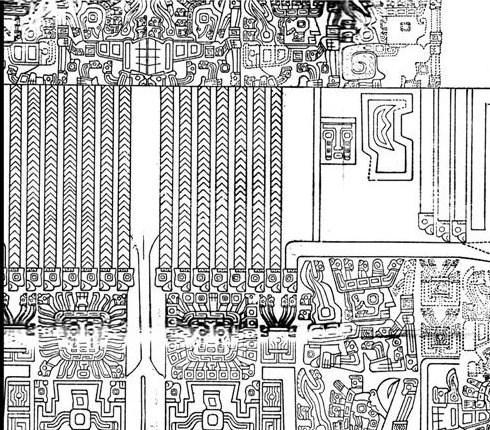
|
 |
 |
 |
 |
 |
|
Gb5-8 |
Gb5-9 |
Gb5-10 (363) |
Gb5-11
(229 + 135) |
Gb5-12 (365) |
|
4h (60.9)
JĪSHUĬ = λ Persei
(60.7)
COR CAROLI (α
Canum Ven.) |
υ Persei (61.2) |
BEID (Egg) = ο¹ Eridani
(62.2),
μ
Persei (62.8)
VINDEMIATRIX
( ε Virginis) |
Al Dabarān-2 (The Follower)
HYADUM I = γ Tauri (63.4)
*22.0 = *63.4 - *41.4 |
HYADUM II = δ¹ Tauri
(64.2) |
|
May 20 (140) |
21 |
22 (54 + 22 * 4) |
23 (*428) |
24 (509) |
|
... Odysseus and his fleet
were now in a mythic realm
of difficult trials and
passages, of which the first
was to be the Land of the
Cyclopes, 'neither nigh at
hand, nor yet afar off',
where the one-eyed giant
Polyphemus, son of the god
Poseidon (who, as we know,
was the lord of tides and of
the Two Queens, and the
lord, furthermore, of
Medusa), dwelt with his
flocks in a cave. 'Yes, for
he was a monstrous thing and
fashioned marvelously, nor
was he like to any man that
lives by bread, but like a
wooded peak of the towering
hills, which stands out
apart and alone from
others.' Odysseus, choosing
twelve men, the best of the
company, left his ships at
shore and sallied to the
vast cave. It was found
stocked abundantly with
cheeses, flocks of lambs and
kids penned apart, milk
pails, bowls of whey; and
when the company had entered
and was sitting to wait,
expecting hospitality, the
owner came in, shepherding
his flocks. He bore a
grievous weight of dry wood,
which he cast down with a
din inside the cave, so that
in fear all fled to hide.
Lifting a huge doorstone,
such as two and twenty good
four-wheeled wains could not
have raised from the ground,
he set this against the
mouth of the cave, sat down,
milked his ewes and goats,
and beneath each placed her
young, after which he
kindled a fire and spied his
guests
...
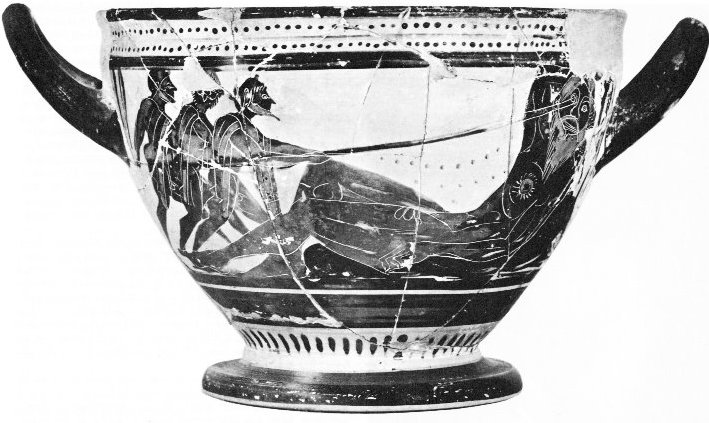 |
|
°May 16 (136) |
17 |
18 |
19 (*424) |
20 (*60) |
|
'April 23 |
24 (114) |
25
(*400) |
26 (*36) |
27 |
|
"April 9 (99) |
10 (465) |
11 |
12 (*22) |
13 |
|
3-14 (73) |
MARCH 15 |
16 (440) |
17 |
18 |
19 (443) |
20 (*364) |
 |
 |
 |
 |
 |
 |
 |
|
Gb8-24 (236) |
Gb8-25 |
Gb8-26 |
(361 + 107) |
Gb8-28 |
Gb8-29 |
Gb8-30 (471) |
|
MENKHIB (Next to the
Pleiades =
ζ
Persei
(57.6)
PORRIMA (γ
Virginis) |
ZAURAK (Boat) = γ Eridani
(58.9) |
λ Tauri (59.3), ν Tauri
(59.9) |
4h (60.9)
JĪSHUĬ = λ Persei
(60.7)
COR CAROLI (α
Canum Ven.) |
υ Persei (61.2) |
BEID (Egg) = ο¹ Eridani
(62.2),
μ
Persei (62.8)
VINDEMIATRIX ( ε Virginis) |
Al Dabarān-2 (The Follower)
HYADUM I = γ Tauri (63.4)
*22.0 = *63.4 - *41.4 |
|
May 17 (137) |
18
(*58) |
19 (*424) |
20 |
21 |
22 |
23 (*428) |
|
°May 13 |
14 (*54) |
15 (*420) |
16 (136) |
17 |
18
(*58) |
19 (*424) |
|
'April 20 |
21 (111) |
22 |
23 |
24 |
25
(*400) |
26 (*36) |
|
"April 6 |
7 |
8 |
9 (464) |
10 (100) |
11 |
12 (*22) |
And in the C text, we should remember,
107 was equal to 392 - 285, i.e. to
80 (Sirrah) + 27 (precessional days
down from my assumed epoch of rongorongo to
that at the First
Point of Aries in Roman times):
|
- |
28
|
te
honu kau |
manu kake rua |
te
henua |
te
honu |
te
rima |
|
 |
 |
 |
 |
 |
 |
|
Ca13-20 (→ 360) |
*Ca14-25
(→ 350) |
*Ca14-26
(→ 364) |
*Ca14-27
(→ 378) |
*Ca14-28
(→ 392) |
*Ca14-29 (→ 406) |
| |
Ko Honga (*346). |
ko Te kena. |
Ko Nuku kehu. |
ko Ngavai. |
ko Oti. |
|
|
Oti. To come
to an end; to suffice,
to be enough:
ku-oti-á, it is
finished; ina kai oti
mo kai, there is not
enough to eat; he-oti
á, there isn't
anymore left, it's the
last one; it's enough
with that. Vanaga. Ta.:
1. Oti, presage
of death. Sa.: oti,
to die. 2. To cut. Mq.:
koti, oti,
id. Sa.: 'oti,
id. Ma.: koti,
id. Churchill. |
|
DZANEB (→ Deneb, Tail) =
ω Piscium (362.4),
γ² Oct. (362.8)
*362.4 - *41.4 = *321.0 |
υ Andromedae (22.9) |
ACHERNAR (End of the
River) = α Eridani
(23.3),
χ
Andromedae (23.6),
τ
Andromedae (23.9) |
ALSEIPH (Scimitar) = φ
Persei
(24.5),
τ
Ceti (24.7) |
No star listed (25) |
ANA-NIA-10
(Pillar-to-fish by)
χ
Ceti (26.1),
POLARIS = α Ursae
Minoris,
BATEN KAITOS
(Belly of the Fish) = ζ
Ceti
(26.6),
METALLAH (Triagle) = α
Trianguli
(26.9) |
|
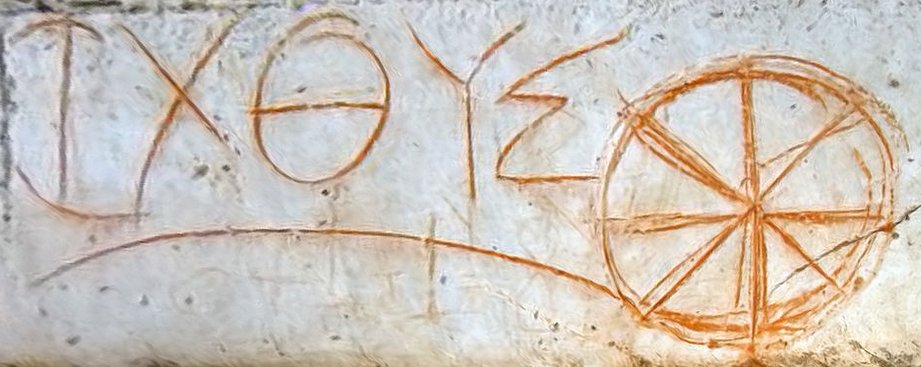 |
|
E tupu |
ki roto |
o te hau tea |
ki te henua - te
maro |
rutua |
|
Rutu.1.
To read, to recite,
to pronounce words
solemnly; he-rutu
i te kohau motu,
to read the
rongorongo tablets;
hare rutu
rogorogo mo hakama'a
ki te ga poki ite
kai, i te rogorogo,
rongorongo
school, house in
which children were
taught reading and
writing the
rongorongo signs. 2.
To pelt with stones.
3. To gather in
great numbers (of
people). Vanaga.
Sound.
Rutu-rongorongo
= the sound of
recitation. Barthel.
T. Beat. Henry. To
recite; tae rutu,
irreverence.
Churchill. Pau.:
rutu, a drum.
Mgv.: rutu,
to beat, to cause to
resound. Ta.:
rutu, a drum, to
drum. Mq.: utu,
to drum. Sa.:
lutu, to shake a
rattle. Churchill.
 |
 |
 |
 |
 |
 |
|
Cb1-1 (393) |
Cb1-2 |
Cb1-3 |
Cb1-4 (396) |
Cb1-5 |
|
CLOSE TO THE SUN: |
|
17 (91 + 16)
Al Sharatain-1 /
Ashvini-1 /
Bond-16 (Dog) /
Mahrū-sha-rishu-ku-1
(Front of the Head
of Ku)
SEGIN = ε
Cassiopeia,
MESARTHIM = γ
Arietis, ψ Phoenicis
(27.2),
SHERATAN (Pair of
Signs) = β Arietis,
φ Phoenicis (27.4)
*351.0 = *27.4 -
*41.4 |
18 (108)
ι Arietis (28.0), λ
Arietis (28.2), υ
Ceti (28.8) |
19
ALRISHA (The Knot) =
α Piscium,
χ Phoenicis (29.2),
ε Trianguli (29.4),
ALAMAK (Caracal) = γ
Andromedae
(29.7)
*353.0 = *29.4 -
*41.4 |
April 20
Arku-sha-rishu-ku-2
(Back of the Head of
Ku)
2h (30.4)
κ
Arietis (30.3),
HAMAL (Sheep) = α
Arietis
(30.5)
ALKES
(α
Crateris) |
21 (111)
DELTOTUM = β
Trianguli
(31.2), ι Trianguli
(31.7), η Arietis
(31.9) |

... The present
limit of the
celestial polar
regions can be
defined from the
declination of the
star
γ
Andromedae
... Its current
place is at
declination 42º 05'
N. In other words
the measure across
the polar regions
should be 2 * (90º -
42º 05') = 2 * 47º
55' = 95º 50' or
around 96º. The
width of the polar
regions is thus
around 2 * 96º =
192º
and 360 - 192 =
168 = 2 * 84 (→
Julian spring
equinox).
... Gamma
Andromedae ...
is the third
brightest star in
the constellation of
Andromeda. It is
also known by the
traditional name
Almach (also
spelt as Almaach,
Almaack,
Almak, Almaak,
or Alamak),
from the Arabic
العناق
الأرض
al-‘anāq al-’arđ ...
'the caracal'
(desert lynx).
Another term for
this star used by
medieval astronomers
writing in Arabic
was
آلرخل
المسلسلة
Al Rijl al
Musalsalah
'the Woman's Foot'.
In Chinese,
天大將軍
(Tiān Dà Jiāng
Jūn), meaning
Heaven's Great
General, refers
to an asterism
consisting of
γ
Andromedae, φ
Persei, 51
Andromedae, 49
Andromedae, χ
Andromedae, υ
Andromedae, τ
Andromedae, 56
Andromedae, β
Trianguli, γ
Trianguli and
δ
Trianguli.
Consequently,
γ
Andromedae itself is
known as
天大將軍一
(Tiān Dà Jiāng
Jūn yī, English:
the
First Star of
Heaven's Great
General.)
In the catalogue of
stars in the
Calendarium of
Al Achsasi al
Mouakket, this star
was designated
جمس
ألنعامة
Khamis al Naamat,
which was translated
into Latin as
Quinta Struthionum,
meaning the fifth
ostrich
... |
|
ko Sive (*351). |
ko Ngehu. |
ko Hatu (*353).
|
ko Tuki. |
ko Bu (*355). |
|
Hatu. 1. Clod of
earth; cultivated
land; arable land (oone
hatu). 2.
Compact mass of
other substances:
hatu matá, piece
of obsidian. 3.
Figuratively:
manava hatu,
said of persons who,
in adversity, stay
composed and in
control of their
behaviour and
feelings. 4. To
advise, to command.
He hatu i te
vanaga rivariva ki
te kio o poki ki
ruga ki te opata,
they gave the
refugees the good
advice not to climb
the precipice; he
hatu i te vanaga
rakerake, to
give bad advice. 5.
To collude, to unite
for a purpose, to
concur. Mo hatu o
te tia o te nua,
to agree on the
price of a nua
cape. 6. Result,
favourable outcome
of an enterprise.
He ká i te umu mo te
hatu o te aga,
to light the earth
oven for the
successful outcome
of an enterprise.
Vanaga. 1. Haatu,
hahatu,
mahatu. To fold,
to double, to plait,
to braid; noho
hatu, to sit
crosslegged; hoe
hatu, clasp
knife; hatuhatu,
to deform. 2. To
recommend.
Churchill. In the
Polynesian dialects
proper, we find
Patu and
Patu-patu,
'stone', in New
Zealand; Fatu
in Tahiti and
Marquesas signifying
'Lord', 'Master',
also 'Stone';
Haku in the
Hawaiian means
'Lord', 'Master',
while with the
intensitive prefix
Po it becomes
Pohaku, 'a
stone'. Fornander. |
|
Gregorian equinox |
'March 22 (81) |
23 (107 - 29) |
24 |
Julian equinox |
|
7 (66 = 80 - 14) |
"March 8 |
9 (68) |
10 |
11 |
|
CLOSE TO THE FULL
MOON: |
|
MUPHRID (Solitary
Star) = η Bootis
(210.1), ζ Centauri
(210.3) |
φ Centauri (211.0),
υ¹ Centauri (211.1),
υ² Centauri (211.8),
τ Virginis (211.9) |
AGENA (At the Knee)
= β Centauri
(212.1), θ Apodis
(212.5),
THUBAN (Dragon) = α
Draconis
(212.8) |
14h (213.1)
π
Hydrae, χ Centauri
(213.0),
MENKENT (Shoulder of
the Centaur) = θ
Centauri
(213.1) |
Neck-2 (Dragon)
ASELLUS TERTIUS (3rd
Ass Colt) = κ
Bootis, κ Virginis,
14 Bootis
(214.8) |
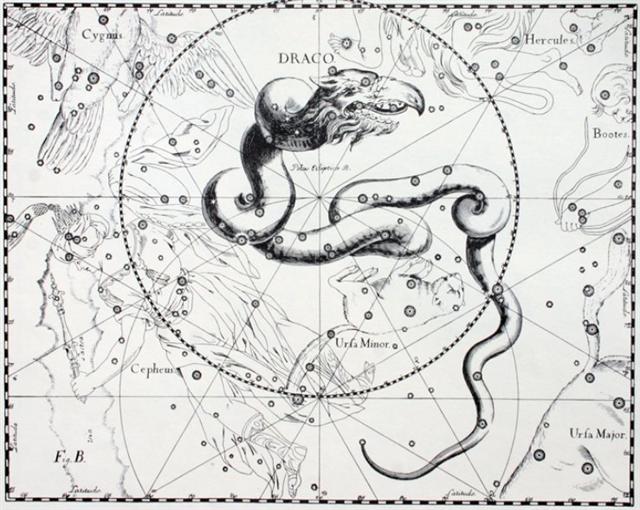
... The sky should
be moving (rutua
te maeva) at the
Caracal - when the
Full Moon would have
been at right
ascension day *29.4
+ *365¼ / 2 = *212 =
at Thuban ...

... Thuban had been
the star at the
North Pole when the
great Egyptian
pyramids where built
... The star could
be seen, both by day
and night, from the
bottom of the
central passage of
the Great Pyramid of
Cheops (Knum
Khufu) at
Ghizeh, in 30° of
north latitude, as
also from the
similar points in
five other like
structures; and the
same fact is
asserted by Sir John
Herschel as to the
two pyramids at
Abousseir ...
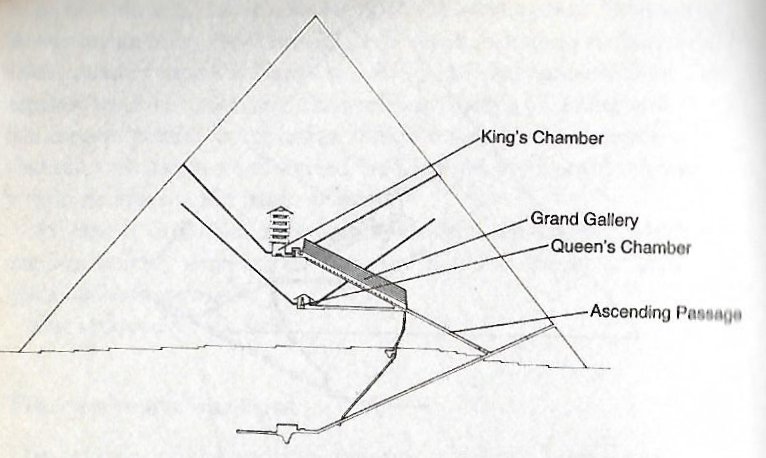
... For some reason,
too, it had taken
their fancy to place
the Great Pyramid
almost exactly on
the 30th parallel at
latitude 29º 58'
51". This, a former
astronomer royal of
Scotland once
observed, was 'a
sensible defalcation
from 30º', but not
necessarily in
error: For if the
original designer
had wished that men
should see with
their body, rather
than their mental
eyes, the pole of
the sky from the
foot of the Great
Pyramid, at an
altitude before them
of 30º, he would
have had to take
account of the
refraction of the
atmosphere, and that
would have
necessitated the
building standing
not at 30º but at
29º 58' 22'
... |
|
'Sept 20 (236 + 27) |
21 |
Equinox |
23 |
24 (267) |
|
|
In the G text we have learned that
also the precessional distance down from
Bharani to Aldebaran was 27 right ascension days:
|
March 21 |
25 |
'March 20 |
21 (80) |
13 |
'April 4 (94) |
25 |
MARCH 24 |
25 (84) |
|
 |
 |
 |
 |
 |
 |
|
Gb6-26 |
Gb7-24 |
Gb7-25 |
Gb8-8 |
Ga1-3 |
Ga1-4 |
|
SIRRAH (*0) |
POLARIS (*26) |
SHERATAN |
BHARANI (*41) |
(*67) |
ALDEBARAN |
|
0h |
April 16 |
17 (107) |
"March 21 |
"April 16 (471) |
17 (107) |
Presumably this message was sent to the
reader for him to understand that in
order to translate from nowadays to the
time of our ancestors the Topknot of
Andromeda corresponded to the Birthplace
at Bharani in ancient times.
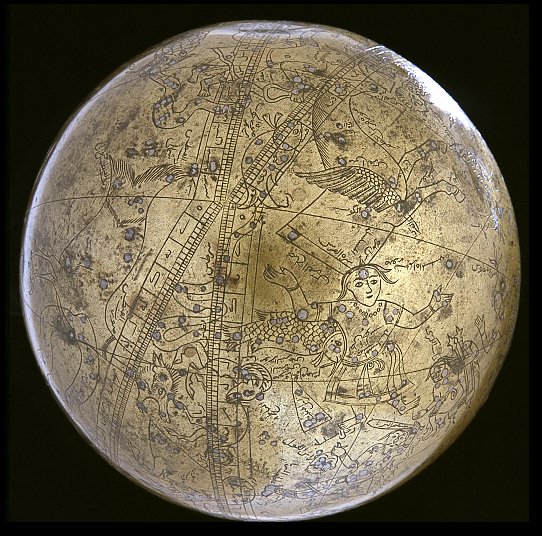
... 'From the time I
was in your womb,' Maui went on,
'I have known the names of these
children of yours. Listen,' he said as
he pointed to his brothers in turn. 'You
are Maui mua, you are Maui
roto, you are Maui taha, and
you are Maui pae. And as for me,
I am Maui potiki, Maui-the-last-born.
And here I am.' When he had finished,
Taranga had to wipe her eyes because
there were tears in them, and she said:
'You are indeed my lastborn son. You are
the child of my old age. When I had you,
no one knew, and what you have been
saying is the truth. Well, as you were
formed out of my topknot you can be
Maui tikitiki a Taranga.' So that
became his name, meaning Maui-formed-in-the-topknot-of-Taranga.
And this is very strange, because women
in those days did not have topknots. The
topknot was the most sacred part of a
person, and only men had them ...
... For the Maori the
past is an important and pervasive dimension
of the present and future. Often referred to
as the 'ever-present now', Maori social
reality is perceived as though looking back
in time from the past to the present. The
Maori word for 'the front of' is mua
and this is used as a term to describe the
past, that is, Nga wa o mua or the
time in front of us. Likewise, the word for
the back is muri which is a term that
is used for the future. Thus the past is in
front of us, it is known; the future is
behind us, unknown. The point of this is
that our ancestors always had their backs to
the future with their eyes firmly on the
past. Our past is not conceived as something
long ago and done with, known only as an
historical fact with no contemporary
relevance or meaning. In the words of a
respected Maori elder: The present is a
combination of the ancestors and 'their
living faces' or genetic inheritors, that is
the present generations. Our past is as much
the face of our present and future. They
live in us ... we live in them ...
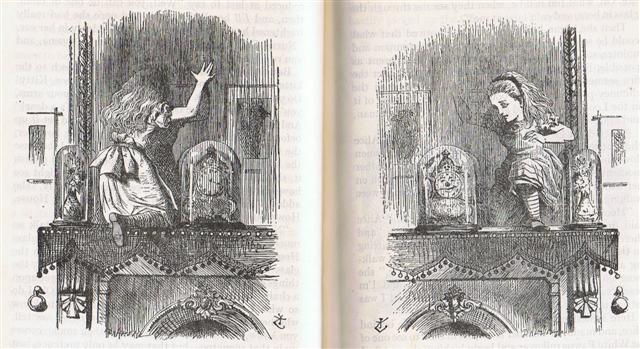
There were 27 days from the Topknot to
the First Point of Aries and similarly
27 days from Bharani to Aldebaran. The
return of the Sun at Sheratan thus
corresponded to the return of the Sun at
Aldebaran.
... In 1903, on the site of the temple
of Dictaean Zeues - the Zeus who was
yearly born in Rhea's cave at Dicte near
Cnossos, where Pythagoras spent 'thrice
nine hallowed days' [27] of his
initiation - was found a Greek hymn
which seems to preserve the original
Minoan formula in which the
gypsum-powdered, sword-dancing Curetes,
or tutors, saluted the Child at his
birthday feast ...
And there were 27 dark days (ages) also in
'Oro-manga.

... They all sat down
and rested [on the plain of Oromanga],
when suddenly they saw that a turtle had
reached the shore and had crawled up on
the beach. He [Ira] looked at it
and said, 'Hey, you! The turtle has come
on land!' He said, 'Let's go! Let's go
back to the shore.' They all went to
pick up the turtle. Ira was the
first one to try to lift the turtle -
but she didn't move. Then Raparenga
said, 'You do not have the necessary
ability. Get out of my way so that I can
have a try!' Raparenga stepped up
and tried to lift the turtle - but
Raparenga could not move her. Now
you spoke, Kuukuu: 'You don't
have the necessary ability, but I shall
move this turtle. Get out of my way!'
Kuukuu stepped up, picked up the
turtle, using all his strength. After he
had lifted the turtle a little bit, he
pushed her up farther. No sooner had he
pushed her up and lifted her completely
off the ground when she struck Kuukuu
with one fin. She struck downward and
broke Kuukuu's spine.The turtle
got up, went back into the (sea) water,
and swam away.

All the kinsmen spoke to you (i.e.
Kuukuu): 'Even you did not prevail
against the turtle!' They put the
injured Kuukuu on a stretcher and
carried him inland. They prepared a soft
bed for him in the cave and let him rest
there. They stayed there, rested, and
lamented the severely injured Kuukuu.
Kuukuu said, 'Promise me, my
friends, that you will not abandon me!'
They all replied, 'We could never
abandon you!' They stayed there
twenty-seven [27] days in Oromanga.
Everytime Kuukuu asked, 'Where
are you, friends?' they immediately
replied in one voice, 'Here we are!'
They all sat down and thought. They had
an idea and Ira spoke, 'Hey, you!
Bring the round stones (from the shore)
and pile them into six heaps of stones!'
One of the youths said to Ira,
'Why do we want heaps of stone?' Ira
replied, 'So that we can all ask the
stones to do something.' They took (the
material) for the stone heaps (pipi
horeko) and piled up six heaps of
stone at the outer edge of the cave.
Then they all said to the stone heaps,
'Whenever he calls, whenever he calls
for us, let your voices rush (to him)
instead of the six (of us) (i.e., the
six stone heaps are supposed to be
substitutes for the youths). They all
drew back to profit (from the deception)
(? ki honui) and listened. A
short while later, Kuukuu called.
As soon as he had asked, 'Where are
you?' the voices of the stone heaps
replied, 'Here we are!' All (the youths)
said, 'Hey, you! That was well done!'
... [E:27-30]
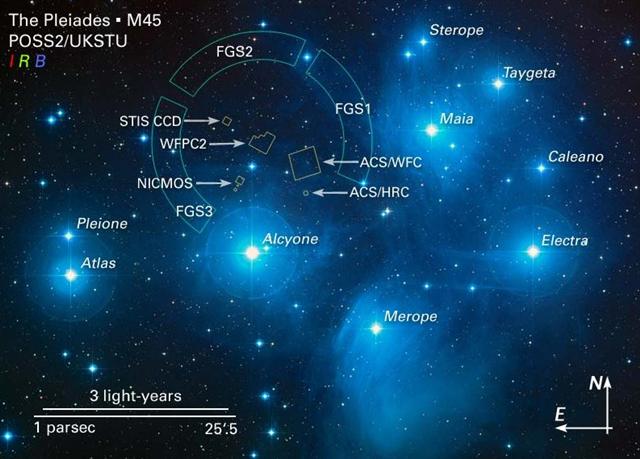
|





























